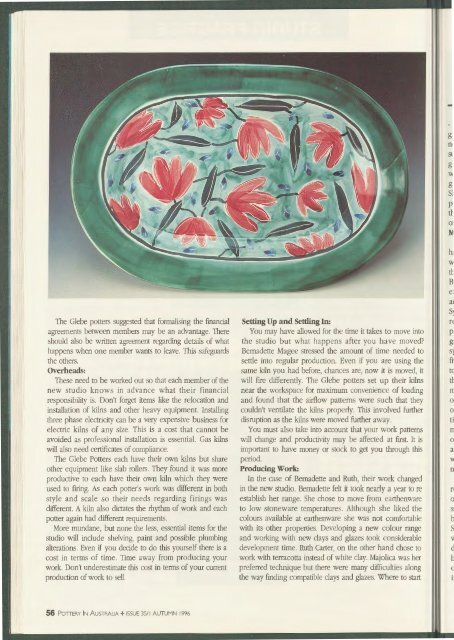Pottery In Australia Vol 35 No 1 Autumn 1996
You also want an ePaper? Increase the reach of your titles
YUMPU automatically turns print PDFs into web optimized ePapers that Google loves.
Sl<br />
g<br />
w<br />
g<br />
SI<br />
P'<br />
tr<br />
o·<br />
M<br />
g<br />
The Glebe potters suggested that formalising the financial<br />
agreements between members may be an advantage. TI1ere<br />
should also be written agreement regarding details of what<br />
happens when one member wants to leave. 1his safeguards<br />
the others.<br />
Overheads:<br />
These need to be worked out so that each member of the<br />
new studio knows in advance what their financial<br />
responsibility is. Don't forget items like the relocation and<br />
installation of kilns and other heavy equipment. <strong>In</strong>stalling<br />
three phase electricity can be a very expensive business for<br />
electric kilns of any size. This is a cost that cannot be<br />
avoided as professional installation is essential. Gas kilns<br />
will also need certificates of compliance.<br />
The Glebe Potters each have their own kilns but share<br />
other equipment like slab rollers. They found it was more<br />
productive to each have their own kiln which they were<br />
used to firing. As each potter's work was different in both<br />
style and scale so their needs regarding firings was<br />
different. A kiln also dictates the rhythm of work and each<br />
potter again had different requirements.<br />
More mundane, but none the less, essential items for the<br />
studio will include shelving, paint and possible plumbing<br />
alterations. Even if you decide to do this yourself there is a<br />
cost in terms of time. Time away from producing your<br />
work. Don't underestimate this cost in terms of your current<br />
production of work to sell.<br />
Setting Up and Settling <strong>In</strong>:<br />
You may have allowed for the time it takes to move into<br />
the studio but what happens after you have moved?<br />
Bernadette Magee stressed the amount of time needed to<br />
settle into regular production. Even if you are using the<br />
same kiln you had before, chances are, now it is moved, it<br />
will fire differently. The Glebe potters set up their kilns<br />
near the workspace for maximum convenience of loading<br />
and found that the airflow patterns were such that they<br />
couldn't ventilate the kilns properly. This involved further<br />
disruption as the kilns were moved further away.<br />
You must also take into account that your work patterns<br />
will change and productivity may be affected at first. It is<br />
important to have money or stock to get you through this<br />
period.<br />
Producing Work:<br />
<strong>In</strong> the case of Bernadette and Ruth, their work changed<br />
in the new studio. Bernadette felt it took nearly a year to re<br />
establish her range. She chose to move from earthenware<br />
to low stoneware temperatures. Although she liked the<br />
colours available at earthenware she was not comfortable<br />
with its other properties. Developing a new colour range<br />
and working with new clays and glazes took considerable<br />
development time. Ruth Carter, on the other hand chose to<br />
work with terracotta instead of white clay. Majolica was her<br />
preferred technique but there were many difficulties along<br />
the way finding compatible clays and glazes. Where to start<br />
h:<br />
w<br />
tr<br />
B<br />
e:<br />
a1<br />
s~<br />
fE<br />
p<br />
g:<br />
S1<br />
fi,<br />
tc<br />
tr<br />
rr<br />
ol<br />
0 1<br />
ti<br />
rr<br />
o<br />
w<br />
rr<br />
re<br />
0<br />
sr<br />
b<br />
S<br />
w<br />
d<br />
b<br />
0<br />
ir<br />
56 POTTERY IN AUSTRALIA+ ISSUE <strong>35</strong>/1 AUTUMN <strong>1996</strong>

















